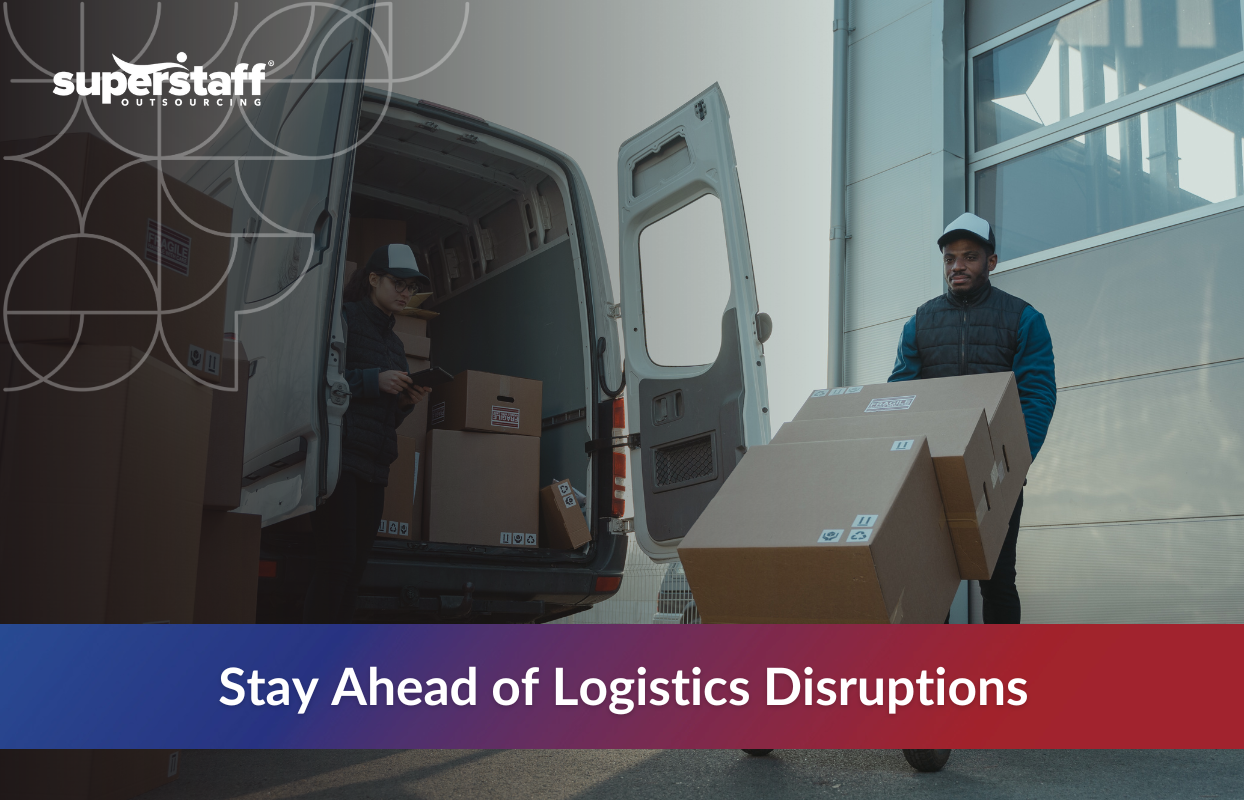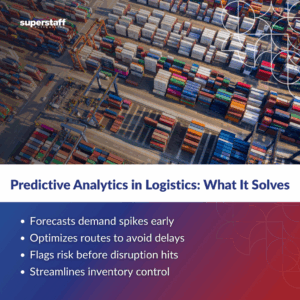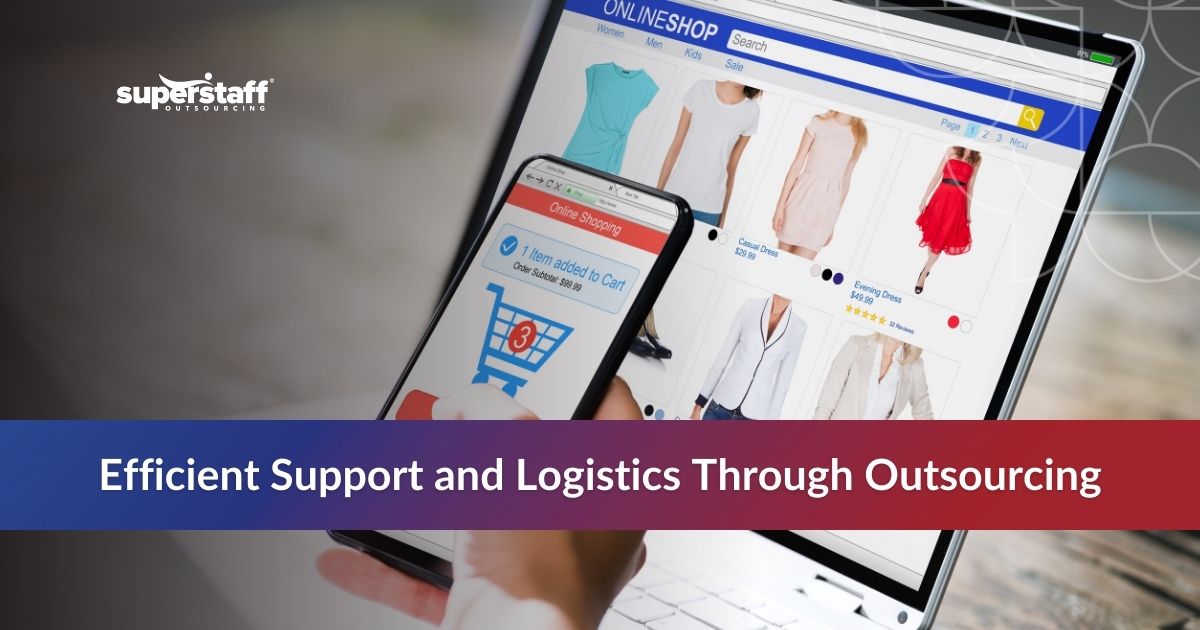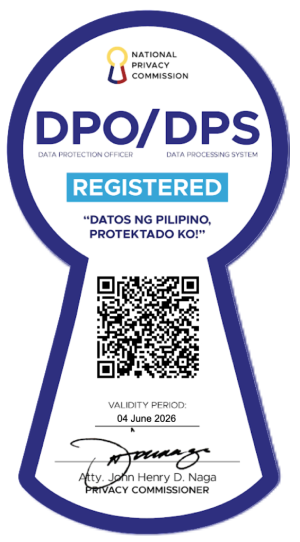
Unplanned delays cost more than just time—they break trust and chip away at your bottom line. In today’s volatile market, companies can’t afford to be caught off guard. Political unrest, port backlogs, labor shortages, fuel price hikes, and extreme weather are pushing logistics leaders to think ahead. It’s no longer enough to respond to problems after they hit. The smartest firms are turning to predictive analytics in logistics to get ahead of disruption before it starts.
This blog explores how predictive analytics is redefining logistics as a proactive function. We’ll break down its real-world applications and explain how outsourcing this capability can give businesses a competitive edge, especially when scalability and resilience are top priorities.
Disruption Is the New Normal in Logistics
Over the last few years, disruptions in logistics have gone from rare events to everyday challenges. The COVID-19 pandemic exposed just how fragile global supply chains could be. Since then, volatility has continued, driven by geopolitical conflicts, shifting trade regulations, labor shortages, and climate-related catastrophes.
Port congestion leaves containers stranded for weeks. Fuel prices fluctuate wildly, making transportation costs unpredictable. And new regulatory requirements in different countries can slow cross-border shipments to a crawl. These aren’t occasional challenges—they’re part of the new baseline.
For logistics companies, this means the cost of failure is rising. Late deliveries can lead to lost contracts, reputation damage, or missed service-level agreements. That’s why the industry is now embracing predictive analytics in logistics to take control of unpredictability.
Disruptions also have downstream effects. When one shipment is delayed, it may trigger stockouts, production delays, or customer churn. That’s why mitigating risk isn’t just a matter of operational efficiency—it’s a matter of business survival. The stakes are higher than ever. In this climate, decision-makers need smarter tools to navigate the chaos and turn volatility into a source of strategic advantage.
Seeing Tomorrow’s Problems Today

What makes predictive analytics in logistics so powerful is its ability to see patterns no human could detect. By analyzing massive amounts of historical data and pairing it with real-time updates, predictive models can spot issues before they escalate.
For example, when analyzing holiday shopping trends, predictive tools can alert businesses to spikes in demand weeks in advance. If weather data shows an approaching storm, predictive systems flag likely delays and offer alternative routes. Even machinery and truck sensors now feed data into models that warn about equipment that’s due for maintenance before it breaks down mid-delivery.
Predictive analytics in logistics turns every data point—from warehouse temps to customs hold times—into a signal. The result is faster response times, smoother operations, and a better ability to shield your supply chain from chaos.
Some logistics firms even use predictive modeling to improve hiring and scheduling. By anticipating seasonal fluctuations and shipment volumes, they can allocate resources more accurately, avoiding overstaffing or understaffing. This strategic staffing approach enhances delivery times while also managing costs—a double win.
Upgrading Logistics with Smarter Functions
Every step of the supply chain benefits from being more intelligent. Predictive analytics in logistics sharpens the core functions that define success in the industry.
Route optimization becomes smarter, accounting for not just distance but traffic, weather, and fuel costs. Inventory planning becomes leaner, as turnover rates can be predicted with greater accuracy. Even risk management becomes dynamic, with real-time scoring that redirects shipments away from storm zones or geopolitical flashpoints.
Smarter fleet management is another area seeing transformation. Companies are using predictive analytics in logistics to understand vehicle wear-and-tear patterns, schedule maintenance proactively, and minimize unexpected breakdowns. These micro-optimizations—when scaled—deliver macro-level efficiency and cost savings.
Demand forecasting is also becoming more granular. Instead of generic, monthly projections, businesses can now generate daily or even hourly forecasts for specific SKUs. These insights are particularly valuable for e-commerce and retail businesses that rely on just-in-time delivery models to meet customer expectations.
These are no longer nice-to-have features—they’re becoming essential. Yet, building and maintaining a full analytics operation in-house can be a burden. That’s where outsourcing steps in as a smart solution.
Why Outsourcing Predictive Analytics Makes Sense
The truth is, many logistics companies aren’t equipped to build a world-class analytics department. It takes specialized talent, advanced platforms, and ongoing maintenance—not to mention a steep investment. But outsourcing levels the playing field.
By partnering with experts, firms gain access to cutting-edge technology and top-tier data science talent. Predictive analytics in logistics doesn’t need to be built from scratch when third-party providers already have the tools and infrastructure in place. The result? Faster implementation, lower upfront costs, and a quicker path to measurable results.
Whether your company is in freight forwarding, last-mile delivery, or warehousing, outsourcing makes predictive capabilities instantly available without the long ramp-up time.
Outsourced partners also bring cross-industry expertise. They work with businesses in multiple sectors, giving them a broader understanding of market signals and risk factors. This makes their insights more robust and transferable. A data-driven logistics solutions provider can adapt strategies to suit your specific niche, whether you’re managing perishable goods, high-value electronics, or industrial supplies.
Another benefit? Compliance. Predictive analytics in logistics can help ensure regulatory adherence by flagging documentation delays or misalignments in trade compliance data. Outsourcing these functions ensures you remain compliant in every region you operate.
Building Resilience, Trust, and Competitive Advantage
The benefits of predictive analytics in logistics go beyond smoother operations—they ripple into customer experience. When disruptions are anticipated and avoided, delivery timelines become more reliable. Customers are kept informed with proactive alerts. Contracts are fulfilled on time. And most importantly, trust is built.
Fewer missed SLAs mean fewer unhappy clients. Fewer delays mean better reputations. In a world where supply chains are increasingly scrutinized, having a predictive layer is becoming a mark of professionalism and preparedness.
Predictive analytics in logistics empowers companies to move from reactive problem-solving to proactive prevention. That shift is key in today’s customer-centric, high-stakes delivery environment.
Many logistics firms are already adopting automation, but it’s predictive analytics that gives automation real strategic value. For example, an automated warehouse that doesn’t know what volume to expect can still face bottlenecks. But pair it with a predictive engine, and now it can pre-position staff, stock, and space for incoming demand—before it arrives.
Predictive Analytics in Logistics: Your Competitive Edge
As supply chains become more complex and fragile, predictive analytics in logistics is emerging as the key to business continuity and growth. It helps companies anticipate disruption, reduce risk, and operate with greater agility and precision.
From smarter inventory management to intelligent routing, the benefits are real—and measurable. Best of all, outsourcing predictive analytics means even small to mid-sized firms can afford these capabilities without building an entire analytics division from scratch.
Whether you’re seeking to expand into new markets or fortify your current operations, now is the time to future-proof your supply chain. With the right predictive tools and partners in place, logistics companies can evolve from reactive to resilient.
SuperStaff can help you integrate data-driven insights into your logistics operations. With scalable solutions, technical expertise, and deep experience in customer-focused industries, we’re ready to be your predictive analytics partner. Let’s future-proof your supply chain—together.






